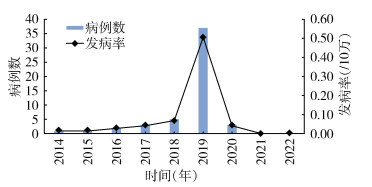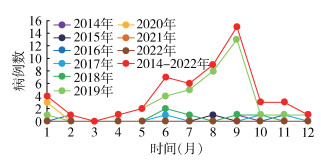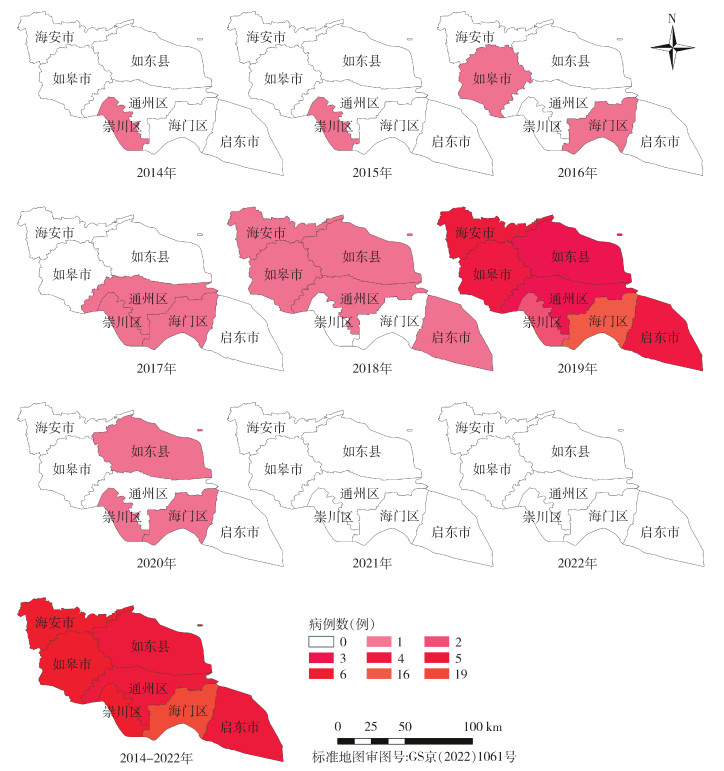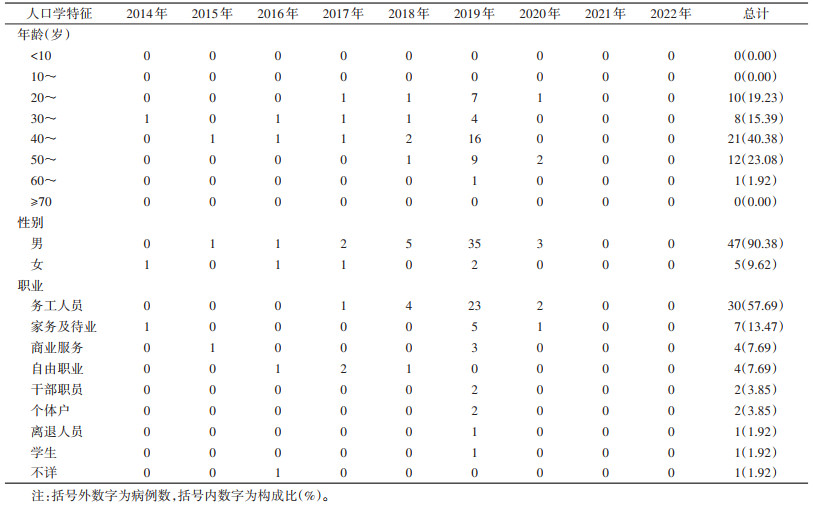| 1 |
World Health Organization. Dengue and severe dengue[EB/OL]. (2022-01-10)[2023-03-10]. https://www.who.int/news-room/fact-sheets/detail/dengue-and-severe-dengue.
|
| 2 |
Brady OJ, Gething PW, Bhatt S, et al. Refining the global spatial limits of dengue virus transmission by evidence-based consensus[J]. PLoS Negl Trop Dis, 2012, 6 (8):e1760.
DOI
|
| 3 |
牟笛, 崔金朝, 殷文武, 等. 2015-2018年我国登革热暴发流行病学特征分析[J]. 中华流行病学杂志, 2020, 41 (5):685-689.
DOI
|
|
Mu D, Cui JC, Yin WW, et al. Epidemiological characteristics of dengue fever outbreaks in China, 2015-2018[J]. Chin J Epidemiol, 2020, 41 (5):685-689.
DOI
|
| 4 |
刘起勇. 我国登革热流行新趋势、防控挑战及策略分析[J]. 中国媒介生物学及控制杂志, 2020, 31 (1):1-6.
DOI
|
|
Liu QY. Dengue fever in China: New epidemical trend, challenges and strategies for prevention and control[J]. Chin J Vector Biol Control, 2020, 31 (1):1-6.
DOI
|
| 5 |
章士军, 王智泉, 陈郁, 等. 南通市首例输入登革热的调查与防制对策[J]. 医学动物防制, 2006, 22 (10):727-729.
DOI
|
|
Zhang SJ, Wang ZQ, Chen Y, et al. Investigation and control strategies of the first imported dengue fever case in Nantong[J]. J Med Pest Control, 2006, 22 (10):727-729.
DOI
|
| 6 |
中国疾病预防控制中心. 登革热防治技术指南[Z]. 北京: 中国疾病预防控制中心, 2014.
|
|
Chinese Center for Disease Control and Prevention. Technical guideline for dengue fever prevention and treatment[Z]. Beijing: Chinese Center for Disease Control and Prevention, 2014. (in Chinese)
|
| 7 |
肖东楼.登革热防治手册[M].2版.北京:人民卫生出版社,2008:3-4.
|
|
Xiao DL.Prevention and treatment manual of dengue fever[M].2nd ed.Beijing:People's Medical Publishing House,2008:3-4.
|
| 8 |
张楠, 王笑辰, 胡建利. 江苏省2011-2017年输入性登革热流行病学特征[J]. 江苏预防医学, 2019, 30 (1):78-79.
DOI
|
|
Zhang N, Wang XC, Hu JL. Epidemiological characteristics of imported dengue fever in Jiangsu province, 2011-2017[J]. Jiangsu J Prev Med, 2019, 30 (1):78-79.
DOI
|
| 9 |
崔朋伟, 包林, 董泽丰, 等. 2011-2019年苏州市登革热流行特征分析[J]. 预防医学, 2021, 33 (3):274-276.
DOI
|
|
Cui PW, Bao L, Dong ZF, et al. Epidemiological characteristics of dengue fever from 2011 to 2019 in Suzhou[J]. Prev Med, 2021, 33 (3):274-276.
DOI
|
| 10 |
Messina JP, Brady OJ, Golding N, et al. The current and future global distribution and population at risk of dengue[J]. Nat Microbiol, 2019, 4 (9):1508-1515.
DOI
|
| 11 |
牟笛, 何泱霓, 陈秋兰, 等. 我国2016年登革热输入和本地病例流行病学特征比较[J]. 疾病监测, 2017, 32 (3):184-189.
DOI
|
|
Mu D, He YN, Chen QL, et al. Comparison of epidemiological features between imported and indigenous dengue fever cases in China[J]. Dis Surveill, 2017, 32 (3):184-189.
DOI
|
| 12 |
王桢, 凌锋, 刘营, 等. 浙江省2015-2019年登革热流行特征分析[J]. 中国媒介生物学及控制杂志, 2020, 31 (6):643-647.
DOI
|
|
Wang Z, Ling F, Liu Y, et al. Epidemiological characteristics of dengue fever in Zhejiang province, China, 2015-2019[J]. Chin J Vector Biol Control, 2020, 31 (6):643-647.
DOI
|
| 13 |
彭维斌, 杨开玺, 徐文斌. 一起由输入病例引起登革热暴发的流行病学调查[J]. 现代预防医学, 2007, 34 (14):2752-2753.
DOI
|
|
Peng WB, Yang KX, Xu WB. Epidemiological investigation of an outbreak of dengue fever caused by imported case[J]. Mod Prev Med, 2007, 34 (14):2752-2753.
DOI
|
| 14 |
叶凌, 谭启龙, 赵剑刚, 等. 浙江省一起海岛地区登革热本地暴发疫情的隐性感染情况调查[J]. 中国媒介生物学及控制杂志, 2020, 31 (3):353-357.
DOI
|
|
Ye L, Tan QL, Zhao JG, et al. An investigation of inapparent infections in a local outbreak of dengue fever in an island area of Zhejiang province, China[J]. Chin J Vector Biol Control, 2020, 31 (3):353-357.
DOI
|
| 15 |
王晶, 罗飞, 何为涛, 等. 广西壮族自治区2016-2020年登革热流行特征分析[J]. 中国媒介生物学及控制杂志, 2023, 34 (1):65-69.
DOI
|
|
Wang J, Luo F, He WT, et al. Epidemiological characteristics of dengue fever in Guangxi Zhuang Autonomous Region, China, 2016-2020[J]. Chin J Vector Biol Control, 2023, 34 (1):65-69.
DOI
|
| 16 |
刘永华, 尹小雄, 张海林, 等. 云南省德宏州2013-2019年登革热流行特征及媒介伊蚊监测分析[J]. 中国媒介生物学及控制杂志, 2021, 32 (2):173-180.
DOI
|
|
Liu YH, Yin XX, Zhang HL, et al. Epidemiological characteristics of dengue fever and monitoring of Aedes vector mosquitoes in Dehong Dai and Jingpo Autonomous Prefecture of Yunnan province, China, 2013-2019[J]. Chin J Vector Biol Control, 2021, 32 (2):173-180.
DOI
|
| 17 |
曾小平, 陈琴, 王明昌, 等. 海口市2010-2020年输入性登革热病例发病至确诊间隔时间及影响因素分析[J]. 海南医学, 2021, 32 (18):2430-2433.
DOI
|
|
Zeng XP, Chen Q, Wang MC, et al. Analysis on the interval time between onset to diagnosis and influencing factors of imported dengue fever cases from 2010 to 2020 in Haikou city[J]. Hainan Med J, 2021, 32 (18):2430-2433.
DOI
|
| 18 |
王成岗, 刘起勇, 姜宝法. 中国登革热患者发病至确诊间隔时间及其影响因素分析[J]. 中华流行病学杂志, 2012, 33 (10):1064-1066.
DOI
|
|
Wang CG, Liu QY, Jiang BF. Time between the onset and diagnosis of dengue fever and related influencing factors in China[J]. Chin J Epidemiol, 2012, 33 (10):1064-1066.
DOI
|
| 19 |
龚甫哲, 龚震宇. 2018年9月世界卫生组织关于登革热疫苗的意见书[J]. 疾病监测, 2019, 34 (3):278-284.
DOI
|
|
Gong FZ, Gong ZY. Dengue vaccine: WHO position paper-September 2018[J]. Dis Surveill, 2019, 34 (3):278-284.
DOI
|
| 20 |
李晋涛. 登革热防治研究进展[J]. 第三军医大学学报, 2019, 41 (19):1902-1907.
DOI
|
|
Li JT. Advances in prevention and control for dengue fever[J]. J Army Med Univ, 2019, 41 (19):1902-1907.
DOI
|









